JEE Main Important Physics formulas
ApplyAs per latest 2024 syllabus. Physics formulas, equations, & laws of class 11 & 12th chapters
Introduction to Graphs Class 8 Questions And Answers provided here. These NCERT Solutions are created by expert team at craeers360 keeping the latest syllabus and pattern of CBSE 2023-23. What is a graph? What is the purpose of graphs? What are the types of graphs? In NCERT solutions for Class 8 Maths chapter 15 Introduction to Graphs, you will get answers to all these questions. The graph is a visual representation of data. The purpose of the graph is to show collected data or numerical facts in visual form so that anyone can understand it easily, quickly and clearly.
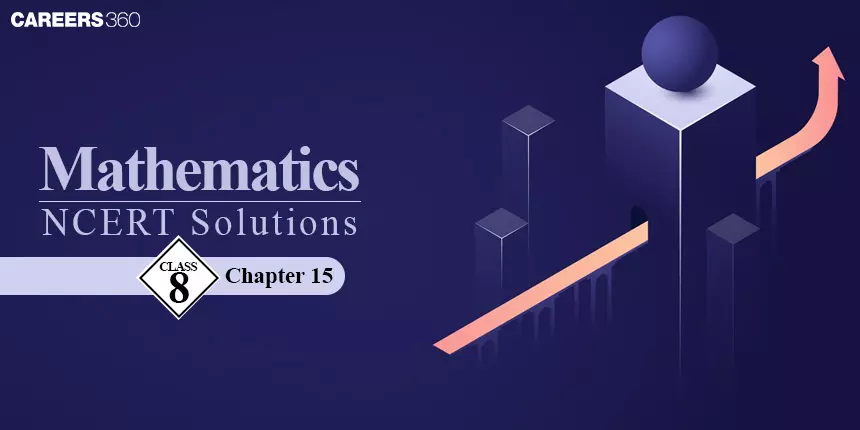
Here you will get the detailed NCERT Solutions for Class 8 Maths by clicking on the link. In Introduction to Graphs class 8 solutions, you will find different types of graphs like - Bar graph, Histogram, Pie graph ( or pie chart or a circle graph), Line graph, and Linear graph in the 3 exercises. These different type of graphs that you will use depends on your data and need. If data changes continuously with the time you will be using a line graph. You can use histogram (bar graph) to show data in any intervals. There are 3 exercises with 65 questions in NCERT the textbook. All these questions are explained in NCERT solutions for Class 8 Maths chapter 15 Introduction to Graphs which will build basic knowledge about the graphs.
Bar Graph: Used to compare categories or discrete data.
Pie Chart: Best for comparing sections of a whole, typically showing proportions.
Histogram: Useful for simplifying data presented in intervals, especially for frequency distributions.
Line Graph: Beneficial for data that changes continuously over time, showing trends and patterns.
Coordinates: To fix a point on a graph, both x-coordinate (horizontal) and y-coordinate (vertical) are required.
Graph: A graph depicts the relationship between a dependent variable and an independent variable, showing how changes in one variable affect the other.
Free download NCERT Solutions for Class 8 Maths Chapter 15 Introduction to Graphs for CBSE Exam.
NCERT Class 8 maths chapter 15 question answer - exercise: 15.1
Question:1(a) The following graph shows the temperature of a patient in a hospital , recorded every hour .
What was the patient's temperature at 1 p.m

Answer:
(a) The patient's temperature at 1 p.m is celsius.
Question:1(b) The following graph shows the temperature of a patient in a hospital recorded every hour.
When was the patients temperature ?

Answer:
(b) The patients temperature is at 12 noon.
Question:1(c) The following graph shows the temperature of a patient in a hospital recorded every hour.

Answer:
(c) The patients temperature was the same two times during the period given these two times are 1 p.m. and 2 p.m.
Question:1(d) The following graph shows the temperature of a patient in a hospital recorded every hour.
What was the temperature at 1:30 p.m? How did you arrive at your answer?

Answer:
(d) The temperature at 1:30 p.m is celsius. The temperature at 1 p.m. to 2 p.m. is same i.e.
celsius so it is also same as at 1:30 p.m is
celsius.
Question:1(e) The following graph shows the temperature of a patient in a hospital recorded every hour.
During which periods did the patients temperature showed an upward trend ?

Answer:
(e) The patients temperature showed an upward trend- 9 am to 10 am., 10 am. to 11 am. and 2pm to 3pm
Question:2(a) The following line graph shows the yearly sales figure for a manufacturing company.
What are the sales in (1) 2002 (2) 2006 ?

Answer:
(a) The sales in
(1) 2002 = 4 crore
(2) 2006 = 8 crore
Question:2(b) The following line graph shows the yearly sales figure for a manufacturing company.
What are the sales in (1) 2003 (2) 2005 ?

Answer:
(b) The sales in
(1) 2003 = 7 crore
(2) 2005 = 10 crore
Question:2(c) The following line graph shows the yearly sales figure for a manufacturing company.
Compute the difference between sales in 2002 and 2006

Answer:
(c) The difference between sales in 2002 and 2006 .
Question:2(d) The following line graph shows the yearly sales figure for a manufacturing company
In which year was there the greatest difference between the sales as compared to its previous year ?

Answer:
(d) The greatest difference between the sales as compared to its previous year is between 2004 and 2005.
How high was Plant A after (i) 2 weeks (ii) 3 weeks?
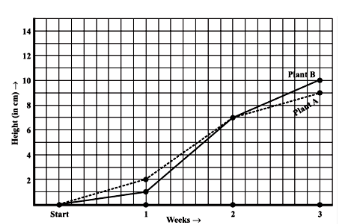
Answer:
(a) The Plant A after
(i) 2 weeks = 7 cm height.
(ii) 3 weeks = 9 cm height.

Answer:
(b) The Plant B after
(i) 2 weeks = 7 cm height.
(ii) 3 weeks = 10cm height.
How much did Plant A grow during the 3rd week?

Answer:
(c)The Plant A grow during the 3rd week =
How much did Plant B grow from the end of the 2nd week to the end of the 3rd week?

Answer:
(d)The Plant B grow from the end of the 2nd week to the end of the 3rd week height.
During which week did Plant A grow most?

Answer:
(e)The week in which Plant A grow most during 2nd week = cm height.
During which week did Plant B grow least?

Answer:
(f) The week in which Plant B grow least is during first week =
Were the two plants of the same height during any week shown here? Specify.

Answer:
(g) At the end of second week, heights of both plants are same.

Answer:
(a) The forecast temperature is the same as the actual temperature on Tuesday, Friday and Sunday.
Question:4(b) The following graph shows the temperature forecast and the actual temperature for each day of a week.
What was the maximum forecast temperature during the week?

Answer:
(b) The maximum forecast temperature during the week was on sunday.
Question:4(c) The following graph shows the temperature forecast and the actual temperature for each day of a week .
What was the minimum actual temperature during the week ?

Answer:
(c) The minimum actual temperature during the week is .
Question:4(d) The following graph shows the temperature forecast and the actual temperature for each day of a week .
On which day did the actual temperature differ the most from the forecast temperature ?

Answer:
(d) The actual temperature differs the most from the forecast temperature on Thursday.
Question:5(a) Use the tables below to draw linear graphs.
The number of days a hill side city received snow in different years.
 Answer:
Answer:
(a) The linear graph of data given above is as shown :
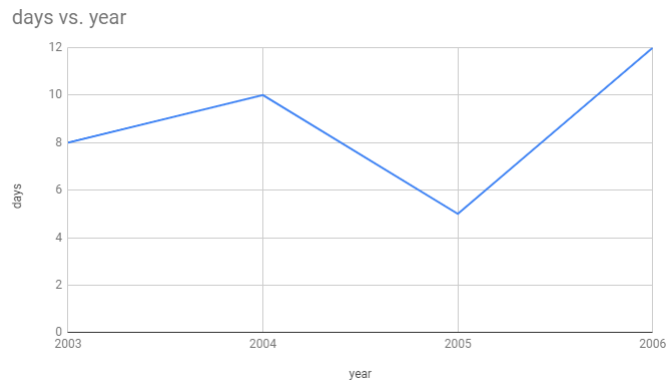
Question:5(b) Use the tables below to draw linear graphs.
Population (in thousands) of men and women in a village in different years.

Answer:
(b) The graph of data given above is as shown :
Taking years as x-axis and population as y- axis.


Answer:
(a) The scale taken for the time axis (x-axis) is 4 units = 1 hour.
How much time did the person take for the travel ?

Answer:
(b) The person travels from 8 a.m. to 11:30 a.m.
the person travels
hours.
How far is the place of the merchant from the town ?

Answer:
(c) The place of the merchant from the town is 22 km away.
Did the person stop on his way? Explain.

Answer:
(d) From 10 a.m. to 10:30 a.m. ,there is a horizontal line which states that person stops from 10 a.m. to 10:30 a.m.
During which period did he ride fastest ?

Answer:
(e) From graph we can observe person travels maximum distance from 8 a.m. to 9 a.m.
Hence,person travels fastest from 8 a.m. to 9 a.m.
Question:7(i) Can there be a time-temperature graph as follows? Justify your answer.

Answer:
(i) Yes, there can be a time-temperature graph as shown with the increase in time, temperature also increases.
Question:7(ii) Can there be a time-temperature graph as follows? Justify your answer.

Answer:
(ii) Yes, it is possible that with increase in time temperature decreases.
Question:7(iii) Can there be a time-temperature graph as follows? Justify your answer.

Answer:
(iii) No,this type of graph is not possible because different temperature at same time are not posiible.
Question:7(iv) Can there be a time-temperature graph as follows? Justify your answer

Answer:
(iv) Yes, it is possible i.e. same temperature at different time is possible.
NCERT Solutions for Class 8 Maths Chapter 15 Introduction To Graphs - Exercise: 15.2
Question:1(i) Plot the following points on a graph sheet. Verify if they lie on a line
A(4, 0), B(4, 2), C(4, 6), D(4, 2.5)
Answer:
(a) A(4, 0), B(4, 2), C(4, 6), D(4, 2.5)
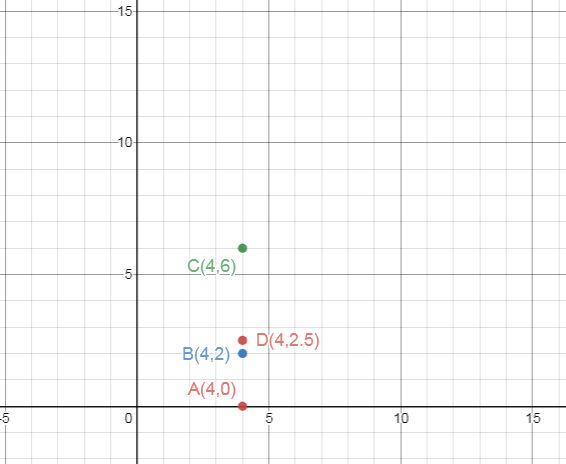
Question:1(b) Plot the following points on a graph sheet. Verify if they lie on a line
P(1, 1), Q(2, 2), R(3, 3), S(4, 4)
Answer:
(b) P(1, 1), Q(2, 2), R(3, 3), S(4, 4)
The graph is as shown :
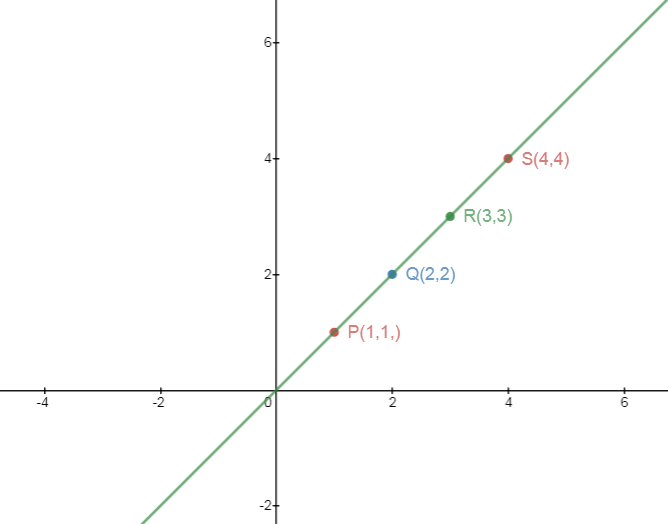
Question:1(c) Plot the following points on a graph sheet. Verify if they lie on a line
K(2, 3), L(5, 3), M(5, 5), N(2, 5)
Answer:
(iii) K(2, 3), L(5, 3), M(5, 5), N(2, 5)
The graph is as shown : 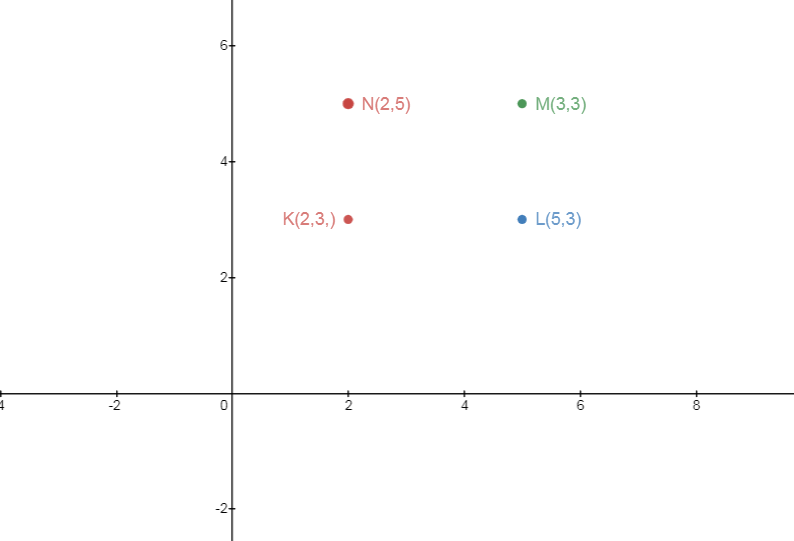
Answer:
As shown below is the graph :
 The coordinates of the points at which this line meets the x-axis and y-axis are
The coordinates of the points at which this line meets the x-axis and y-axis are
Question:3 Write the coordinates of the vertices of each of these adjoining figures.

Answer:

The coordinates of vertices are:
,
,
,
,
,
,
,
,
Question:4(i) State whether True or False. Correct that are false.
A point whose x coordinate is zero and y-coordinate is non-zero will
lie on the y-axis .
Answer:
(i) True .A point whose x coordinate is zero and y-coordinate is non-zero will
lie on the y-axis. = here, y is variable.
Question:4(ii) State whether True or False. Correct that are false.
A point whose y coordinate is zero and x-coordinate is 5 will lie on y-axis.
Answer:
(ii) False.Point does not lie on y-axis.A point whose y coordinate is zero and x-coordinate is 5 will not lie on
y-axis.
Question:4(iii) State whether True or False. Correct that are false.
The coordinates of the origin are (0, 0).
Answer:
(iii)True. The coordinates of the origin are (0, 0).
NCERT Solutions for Class 8 Maths Chapter 15 Introduction To Graphs - Topic 15.3 Some Applications
Question:1 In the above example, use the graph to find how much petrol can be purchased for Rs 800.

Answer:
From the graph given below we can say that for Rs 800 we can buy 16 litres.

Answer:
Taking a case of direct variation the graph is as shown below.
Taking sum deposite as 100,200,300,500 ,1000.
and 10% Simple Interest (S.I.).

Class 8 introduction to graphs NCERT solutions - Exercise: 15.3
Question:1(a) Draw the graphs for the following tables of values, with suitable scales on the axes.
Cost of apples
Answer:
(a) Cost of apples


Question:1(b) Draw the graphs for the following tables of values, with suitable scales on the axes . Distance travelled by a car.
(i)How much distance did the car cover during the period 7.30 a.m. to 8 a.m?
 Answer:
Answer:
(b) 
(i)From the above graph,the distance the car cover during the period 7.30 a.m. to 8 a.m is
Question:1(b) Draw the graphs for the following tables of values, with suitable scales on the axe.
(ii) What was the time when the car had covered a distance of 100 km since it’s star
Answer:
(b)
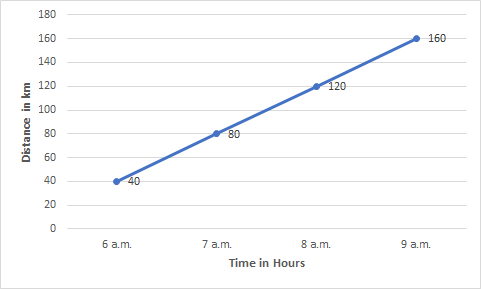
(ii)From above graph we conclude that at 7:30 a.m., the car had covered a distance of 100 km since it’s start.
Question:1(c) Interest on deposits for a year.

(i) Does the graph pass through the origin?
Answer:
(c)
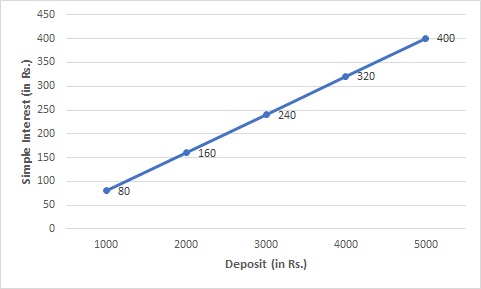
Taking x axis as 1000 units = 1 box and y axis as 100 units = 1 box.
(i)Yes, the graph pass through the origion.
Question:1(c) Interest on deposits for a year

(ii) Use the graph to find the interest on Rs 2500 for a year.
Answer:
(c)
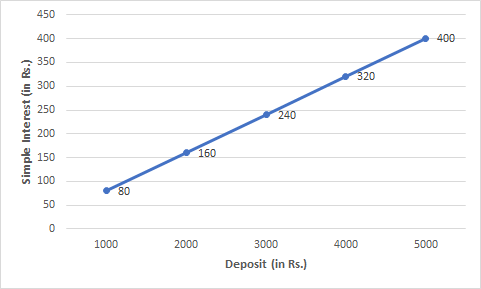
(ii) Using the graph, the interest on Rs 2500 for a year is Rs 200.
Question:1(c) Interest on deposits for a year.
 (iii) To get an interest of Rs 280 per year how much money should be deposited ?
(iii) To get an interest of Rs 280 per year how much money should be deposited ?
Answer:
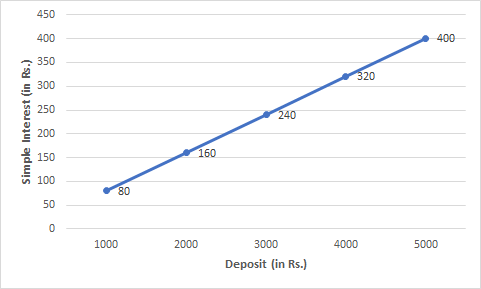
(iii) From the graph,to get an interest of Rs 280 per year Rs 3500 money should be deposited.
Question:2(i) Draw a graph for the following Is it a linear graph
Answer: 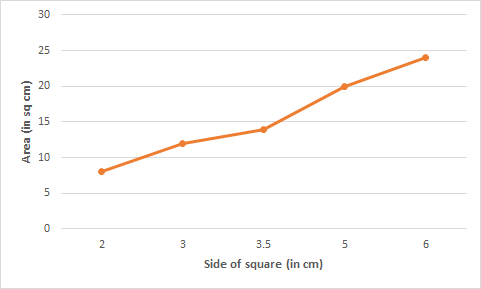
From the above graph ,we conclude that graph is linear.
Question:2(ii) Draw a graph for the following
Answer: 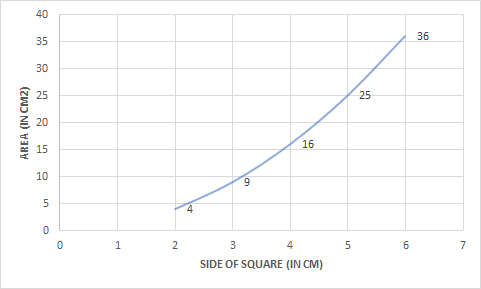 From above graph,we conclude that graph is not linear.
From above graph,we conclude that graph is not linear.
Chapter -1 | |
Chapter -2 | |
Chapter-3 | |
Chapter-4 | |
Chapter-5 | |
Chapter-6 | |
Chapter-7 | |
Chapter-8 | |
Chapter-9 | |
Chapter-10 | |
Chapter-11 | |
Chapter-12 | |
Chapter-13 | |
Chapter-14 | |
Chapter-15 | Introduction to Graphs |
Chapter-16 |
Comprehensive Coverage: Maths chapter 15 class 8 solutions cover all topics and concepts related to graph representations and interpretations as per the Class 8 syllabus.
Step-by-Step Solutions: Class 8 maths ch 15 question answer are detailed, step-by-step explanations for each problem, making it easy for students to understand and apply mathematical concepts related to graphs.
Variety of Problems: A wide range of problems, including exercises and additional questions, to help students practice and test their understanding of graphical representations.
NCERT Solutions for Class 8 Maths chapter 15 Introduction to Graphs - Benefits
Bar graph, Pie graph, histogram, line graph, linear graphs, location of a point on graph, coordinates, and some applications of graphs are covered in this chapter.
NCERT solutions are provided in a very detailed manner which will give conceptual clarity to the students. Also, they can take help from solutions if they are not able to solve NCERT problems on their own.
Here you will get the detailed NCERT solutions for class 8 by clicking on the link.
Here you will get the detailed NCERT solutions for class 8 maths by clicking on the link.
There are 16 chapters starting from rational number to playing with numbers in the CBSE class 8 maths.
NCERT official is the official website of the NCERT where you can get NCERT textbooks and syllabus from class 1 to 12.

As per latest 2024 syllabus. Physics formulas, equations, & laws of class 11 & 12th chapters

Get up to 90% scholarship on NEET, JEE & Foundation courses

As per latest 2024 syllabus. Chemistry formulas, equations, & laws of class 11 & 12th chapters

Enrol in PACE IIT & Medical, Financial District, Hyd for JEE/NEET preparation

Start your JEE preparation with ALLEN

Ace your NEET preparation with ALLEN Online Programs